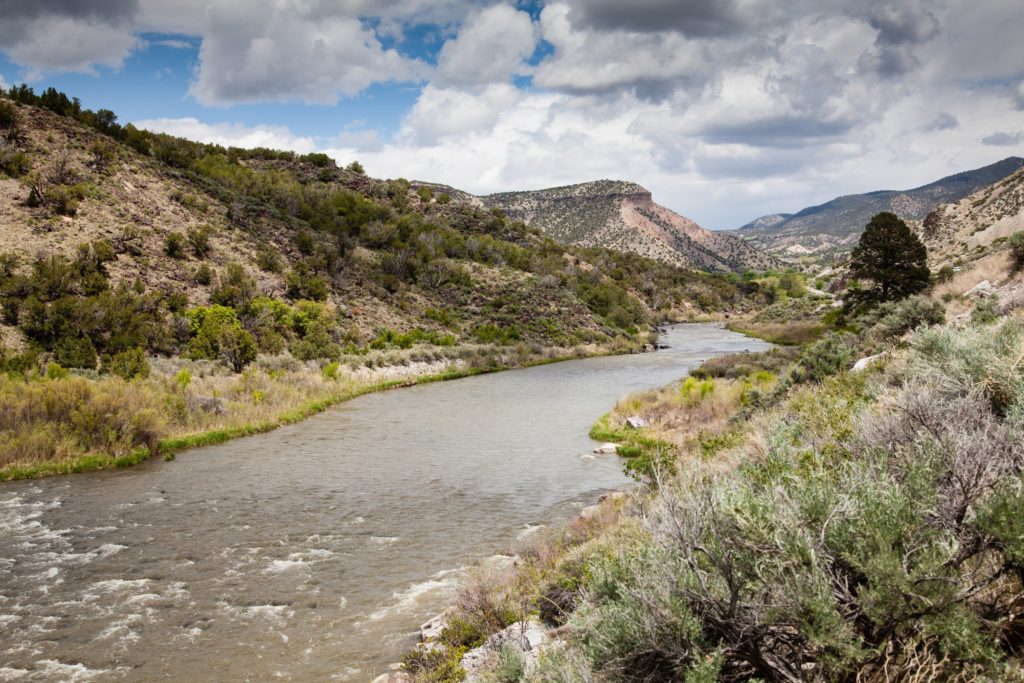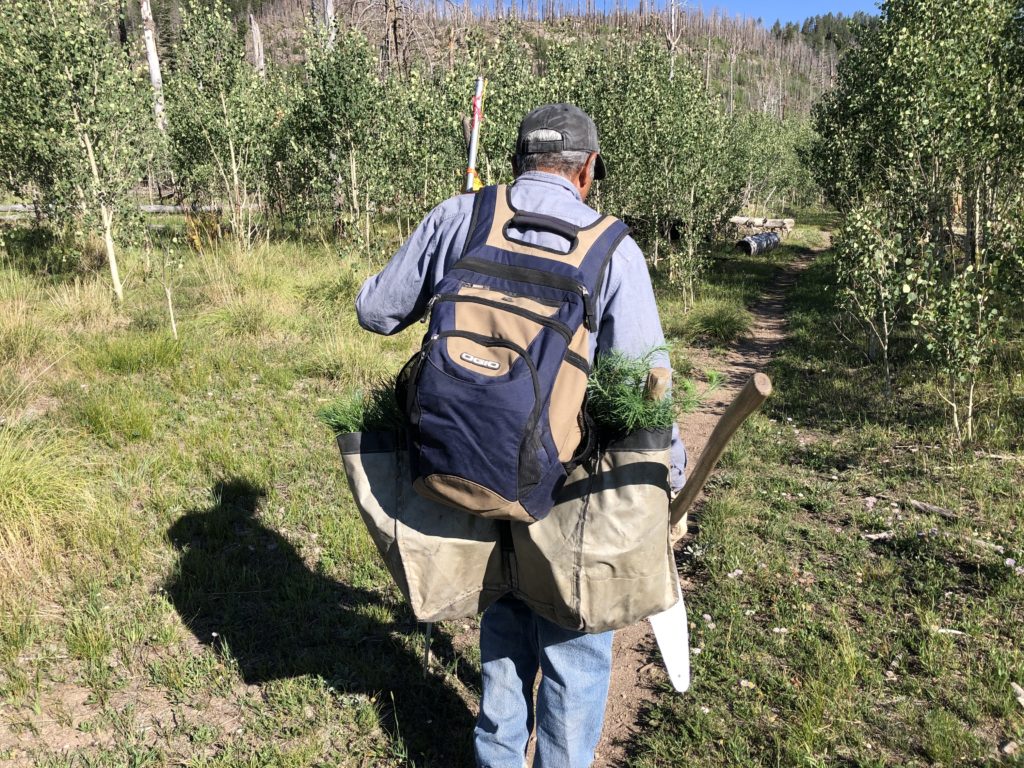Last updated on February 14th, 2024

Imagine your favorite forested area without big, beautiful pine trees cooling you from the sun or providing fresh air during your hike. That’s what New Mexicans across the Jemez Mountains faced when the region was scorched by the Las Conchas Fire in 2011. The flames burned so hot that thousands of acres were left without trees, or the seed sources for natural forest recovery. Heavy rains that followed the fire sent ash and sediment down the Rio Grande River, the pollution preventing downstream cities from withdrawing water for 40 days.
Water is life and livelihood. Nowhere is that a truer statement than in New Mexico. Each year, large and severe wildfires and post-fire flooding increasingly put our water sources at risk. State and federal agencies spend hundreds of millions of dollars each year responding to these fires. Communities affected by severe wildfire face loss of revenue to local businesses, loss of outdoor cultural opportunities. Without action, New Mexico’s future water security and nature-based culture are at significant risk.
To address this challenge, The Nature Conservancy and a broad network of stakeholders formed the Rio Grande Water Fund (RGWF) to work cooperatively to reduce the risk of megafires, protect precious water supplies and build resilience against climate change threats.
This public-private coalition of 100 signatories – including non-profits, tribes, government agencies, and businesses – are working collaboratively to scale up restoration with a goal of improving the health of 600,000 acres of New Mexico’s forested watersheds to secure water for 1 million people. The RGWF is designed to generate sustainable funding for a 20-year program of large-scale forest restoration treatments which include projects to thin overgrown forests, restore wetlands and streams, engage youth, inform policy makers with our science and generate forestry and wood products jobs.
Surprisingly, thinning forests followed by controlled burns is an important climate solution. On the surface, it seems like a way to lose precious carbon. However, it’s important to understand that fire is a natural process and has always been a part of western forests. Forests need fire to recycle nutrients, reduce competition between trees, and prepare seedbeds for the next generation. Until the early 1900’s Indigenous Peoples used fire to protect their homes, water and cultural traditions. European settlers changed the forest, bringing livestock that ate the grass that carried ground fire and removed large fire resistant trees. In the early and mid-20th century, fire was considered the enemy of forests, and most fires were suppressed, leaving a backlog of dense small, flammable trees.
Now, hotter and drier temperatures, coupled with our overcrowded forests, encourage fire behavior that is much more intense, releasing huge amounts of carbon into the air all at once. By improving the health of our forests, we’re making them more resilient, stabilizing carbon and increasing carbon capture as healthy trees continue to grow. Healthy forests absorb more carbon dioxide, storing it in large trees, helping cool our planet.
Because the Las Conchas Fire left no seed sources across thousands of acres of scorched land, The Nature Conservancy expanded the Rio Grande Water Fund work to include an innovative reforestation effort supported by many partners.

TNC is working with research scientists to find the most drought resistant “mother trees” for seeds, grow seedlings in a way that makes them more drought hardy , then plant “tree-islands” – small clusters of trees – in the burned areas of the Jemez Mountains. These tree islands will serve as the seed sources for the future. Using new projections of climate change impacts, and our understanding of what trees need to grow, we identify places where trees have a stronger likelihood to survive in the future. Additionally, our local Indigenous partners from the local Pueblo communities add more value to the work by sharing which tree species locations are culturally important. They also lead the planting operation.
Reducing the risk of damaging wildfires – and planting in areas where natural tree regeneration is unlikely – are forest strategies that together help maintain and increase carbon storage on the landscape. Since 2014, RGWF partners have thinned and conducted controlled burns on nearly 150,000 acres to prevent catastrophic wildfires, while planting in tandem to capture carbon, protect water, and create wildlife habitat.
One reason for the RGWF’s success is its collaboration across boundaries and between organizations working at all scales. The USDA Forest Service, the New Mexico Dept. of Game and Fish and the Water Utility Authority for Albuquerque and Bernalillo County are some of our larger Water Fund partners. At a more local scale, we work with the Cerro Negro Forest Council, a collaborative of people from traditional Hispanic villages near Taos, New Mexico. Members thin forest plots to reduce fire risk, and then can sell the wood they produce to provide income for their families. The project is managed by a local “Mayordomo”, a governance system modeled on the centuries-old irrigation management system used by these communities.

Part of the challenge of large-scale work to mitigate climate impacts is having enough people available and trained to do the needed work. The Rio Grande Water Fund supports the “All Hands All Lands” (AHAL) controlled burning program that builds capacity of forestry workers to use fire well and uses a cooperative burning projects to put more good fire on the ground. Federal fire workers that we depend on to do the burning need to make forests resilient are often called on to fight fires outside New Mexico. Engaging more skilled people to put good fire on the ground is way to help everyone make progress. According to Dave Lasky, the Forest Stewards Guild leader who manages the AHAL Burn Team, “The goal of the AHAL is to get ahead of prescribed fire backlogs on federal, state and tribal lands and support private landowner’s use of prescribed fire.”
Healthy forests lead to healthy livelihoods. Vibrant, resilient forests protect our water, provide wildlife habitat, support the state’s outdoor recreation and forest products economy. Even more importantly – as climate change bears down – healthy forests can store more carbon dioxide to help cool our planet and improve our quality of life.
Portions of this article were adapted from The Rio Grande Water Fund’s 2020 Annual Report
For more information, read about the Rio Grande Water Fund at their website and at Nature.Org.
Anne Bradley is the Forest Program Director at The Nature Conservancy in New Mexico.
